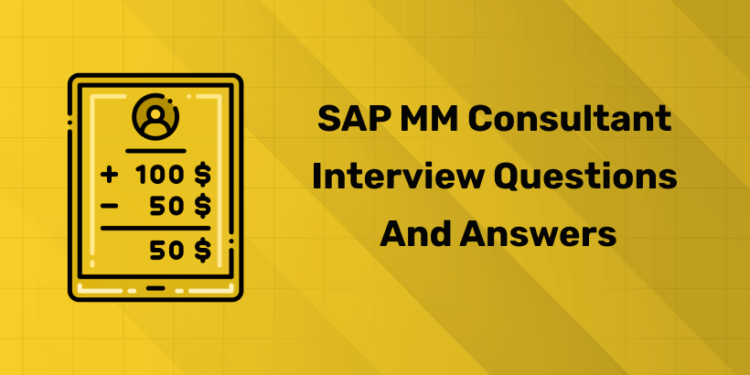Table of Contents
An SAP MM Consultant is key to the supply chain, procurement and inventory of an organization. To prepare for an SAP MM Consultant interview you need to know SAP MM and be able to talk about it. This post has all the SAP MM Consultant interview questions and answers you need for your next interview.
SAP MM Consultant Interview Questions and Answers
SAP MM (Materials Management) Consultant interview questions can be basic to advanced and are about troubleshooting and thinking critically about system implementation and maintenance. Here are some of the most common SAP MM Consultant interview questions:
1. What is SAP MM?
Answer: SAP MM is Materials Management in SAP ERP. Procurement, inventory and material valuation. Integrates with FI, SD, PP and all that stuff to make life in the supply chain easier.
2. Explain the procurement process in SAP MM?
Answer: Procurement in SAP MM is: Identify the need, create a purchase requisition, convert to PO and send to vendor. Vendor delivers, system logs GR, verify IV and then pay.
Elevate your Career with Professional Accounting Course! Get free Demo Here!
3. What are the key components of SAP MM?
Answer: SAP MM consists of several key components:
- Material Master Data: Contains information about materials an organization procures, manufactures, stores, and ships.
- Vendor Master Data: Stores data related to vendors from whom materials and services are procured.
- Purchasing: Manages procurement processes, purchase orders, and contracts.
- Inventory Management: Handles stock levels, goods movements, and physical inventory.
- Invoice Verification: Ensures the accuracy of vendor invoices and processes payments.
- Material Requirement Planning (MRP): Ensures materials are available for production and sales.
4. How do you integrate SAP MM with other SAP modules?
Answer: SAP MM integrates with several other SAP modules to ensure efficient business operations:
- SAP FI (Finance): Integration for accounting entries related to procurement and inventory.
- SAP SD (Sales and Distribution): Integration for sales order processing and inventory control.
- SAP PP (Production Planning): Integration for material requirement planning and production orders.
- SAP QM (Quality Management): Integration for quality inspections and material certifications. This integration facilitates seamless data flow and process automation across different business functions.
5. What is a Purchase Requisition in SAP MM?
Answer: A Purchase Requisition (PR) in SAP MM is an internal document that signals a need for materials or services. It is created by various departments and sent to the purchasing department for procurement. The PR specifies details like material type, quantity, and required date, and can be converted into a purchase order (PO) after approval.
6. What is the difference between a Purchase Requisition and a Purchase Order?
Answer: A Purchase Requisition (PR) is internal and says we need something and what we need. A Purchase Order (PO) is external and sends to the vendor with all the terms, quantities, prices and dates we agreed to for that something.
7. What is a Material Master Record in SAP MM?
Answer: Material Master Record in SAP MM is a big database that has all the details of a material – description, unit of measure, material type, procurement type and storage location. It’s used across all modules so we have consistency and accuracy in all transactions of that material.
8. How to do Goods Receipt in SAP MM?
Answer: Go to goods receipt transaction (MIGO). Enter PO number, check quantities and materials against PO and post. That updates inventory and creates an accounting entry for goods received.
9. What is Invoice Verification in SAP MM?
Answer: Invoice Verification in SAP MM is a big step. It’s comparing the vendor’s invoice with the PO and goods receipt. Quantities, prices and terms on the invoice versus what we agreed to. Once verified, invoice is approved for payment and procurement is complete.
10. What is a Purchase Info Record in SAP MM?.
Answer: A Purchase Info Record in SAP MM links a specific material with a specific vendor, storing crucial procurement information like the last purchase price, delivery lead time, and terms of delivery. It helps streamline the procurement process by providing quick access to vendor-specific data for repeat purchases.
Take Your Career to New Heights with Our Professional Accounting Course! Get free Demo Here!
11. Explain the concept of a “Movement Type” in SAP MM.
Answer: Movement Types in SAP MM categorize the different types of material movements within the system. Each movement type in SAP MM corresponds to specific operations such as goods receipt (101), goods issue (201), or stock transfer (301).
12. What is a Stock Transport Order (STO) in SAP MM?
Answer: A Stock Transport Order (STO) in SAP MM is used to transport material from one plant or storage location to another within the same company. It helps to manage internal stock movements and to have traceability and control. STO process includes creation of order, goods issue at sending plant and goods receipt at receiving plant.
13. What is the difference between a “Stock” and a “Non-Stock” item in SAP MM?
Answer: Stock items are materials which are physically stored in inventory and managed through stock levels. These items go through processes like goods receipt, storage and issue. Non-stock items are procured as and when needed and consumed directly without being stored in inventory. This topic is frequently asked in SAP MM Consultant interview questions.
14. How to handle consignment stock in SAP MM?
Answer: In SAP MM there are specific procedures for consignment stock. When consignment goods arrive system records them without any immediate financial transaction as ownership is with the vendor. When consumption happens system recognizes liability to the vendor and processes payment based on the quantity consumed.
15. What is the purpose of Material Ledger in SAP MM?
Answer: Material Ledger in SAP MM is a subledger for materials, for actual costing and multi-currency valuation. It gives detailed cost transparency and helps to track the actual cost of materials by considering exchange rate fluctuations and production variances. This helps in better financial reporting and decision making.
16. What is the importance of Batch Management in SAP MM?
Answer: Batch Management in SAP MM is crucial for industries where materials are produced or procured in batches. It enables tracking and managing batches from production to distribution, ensuring consistent quality control and traceability. Batch numbers help identify specific production lots, facilitating recall processes and regulatory compliance.
17. What is InfoSet and MultiProvider
Answer: An InfoSet is a virtual table that combines data from different InfoProviders in SAP BW. It allows you to analyze data that isn’t provided by a standard InfoProvider.
A MultiProvider is a logical view that combines data from several InfoProviders in SAP BW. It lets you analyze data as if it were in one InfoProvider.
18. What is Matchcode W
Answer: Matchcode W is a super useful tool to get to the employee records you need to do your job. Matchcode W is an SAP HR feature that lets you search for employee records using various criteria. The criteria includes general and employee specific options like employee name, address, personnel number, personnel area and organizational unit.
Conclusion
1: Accounting provides information on
To ace an SAP MM Consultant interview you need to have in-depth knowledge of SAP MM and be able to express it well. Go through these questions and craft your answers well and you will be ready to get your next SAP MM Consultant role. These SAP MM Consultant Interview Questions and Answers covers all the areas that interviewer will ask. Good luck!
Discover the comprehensive SAP MM course by Entri, designed to equip you with essential skills in materials management. Learn more about the course and enroll here: Entri SAP MM Online Course.
Accounting courses we offer |
Accounting courses in Different Cities |
| Business Accounting & Finance Certification | |
| Tally Course | |
| Taxation Course | |
| UAE Accounting Course | |
| GST Course |
Frequently Asked Questions
What is SAP MM and what are its key functionalities?
SAP MM (Materials Management) is a module of SAP ERP that deals with procurement and inventory management. Key functionalities include procurement processes, inventory management, material valuation, and invoice verification.
What is the purpose of the material master in SAP MM?
The material master in SAP MM is a central repository that contains all essential information about materials that an organization procures, produces, stores, and sells.
What is SAP?
SAP stands for System Application Products in Data Processing. It’s an enterprise resource planning (ERP) software that helps organizations manage their business operations. It is widely used by companies worldwide to streamline their processes and improve efficiency.
What is an ERP?
ERP stands for enterprise resource planning. Organizations use ERP systems to manage day-to-day operations like project management, accounting, human resources, supply chain, manufacturing and procurement.
What are some drawbacks of SAP?
SAP is expensive to implement and requires experienced personnel for successful implementation. The implementation time of SAP is lengthy, with a need for periodic upgrades and maintenance. The SAP application is complex, which is why businesses only implement a single function at a time, allowing employees enough time to understand and get acquainted with the software.











